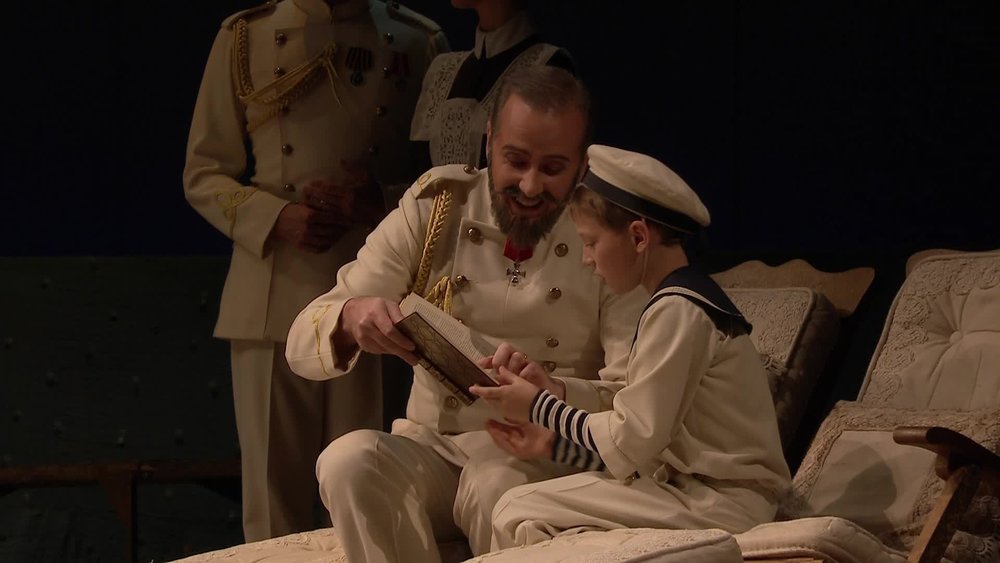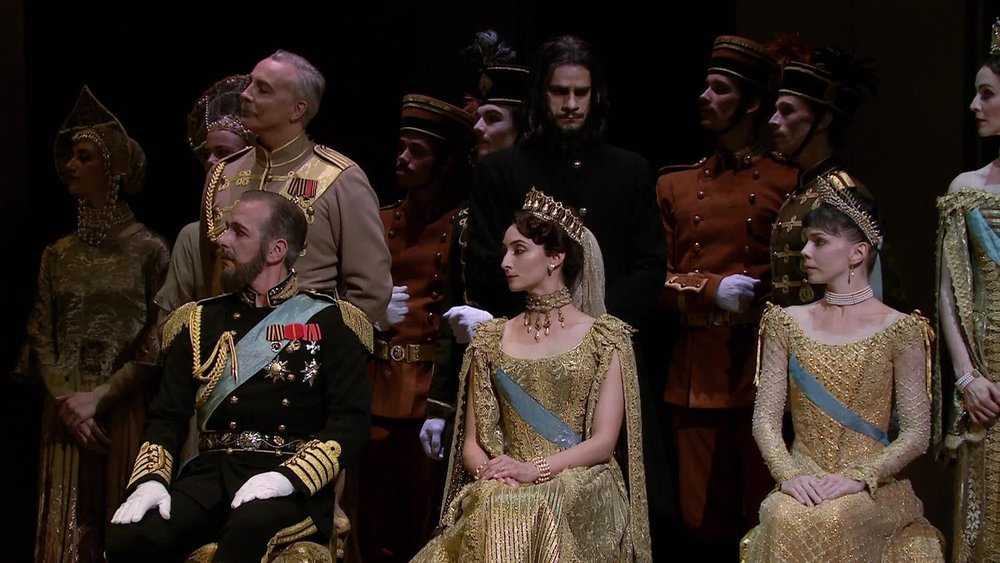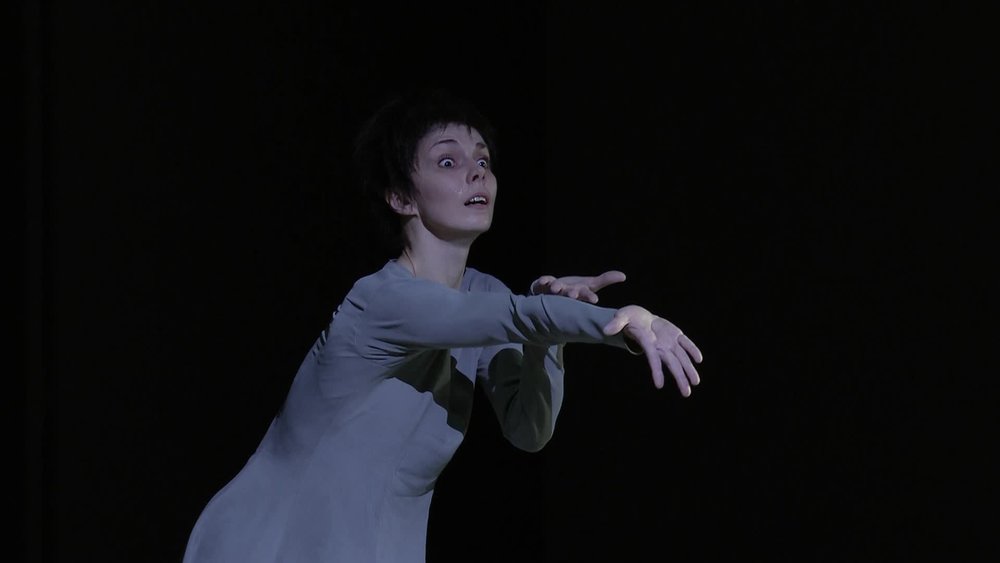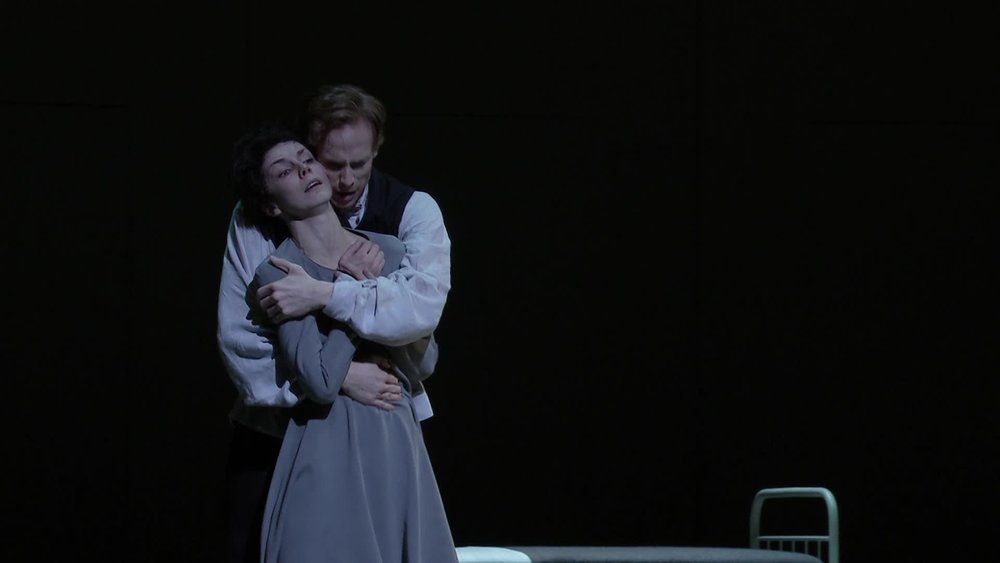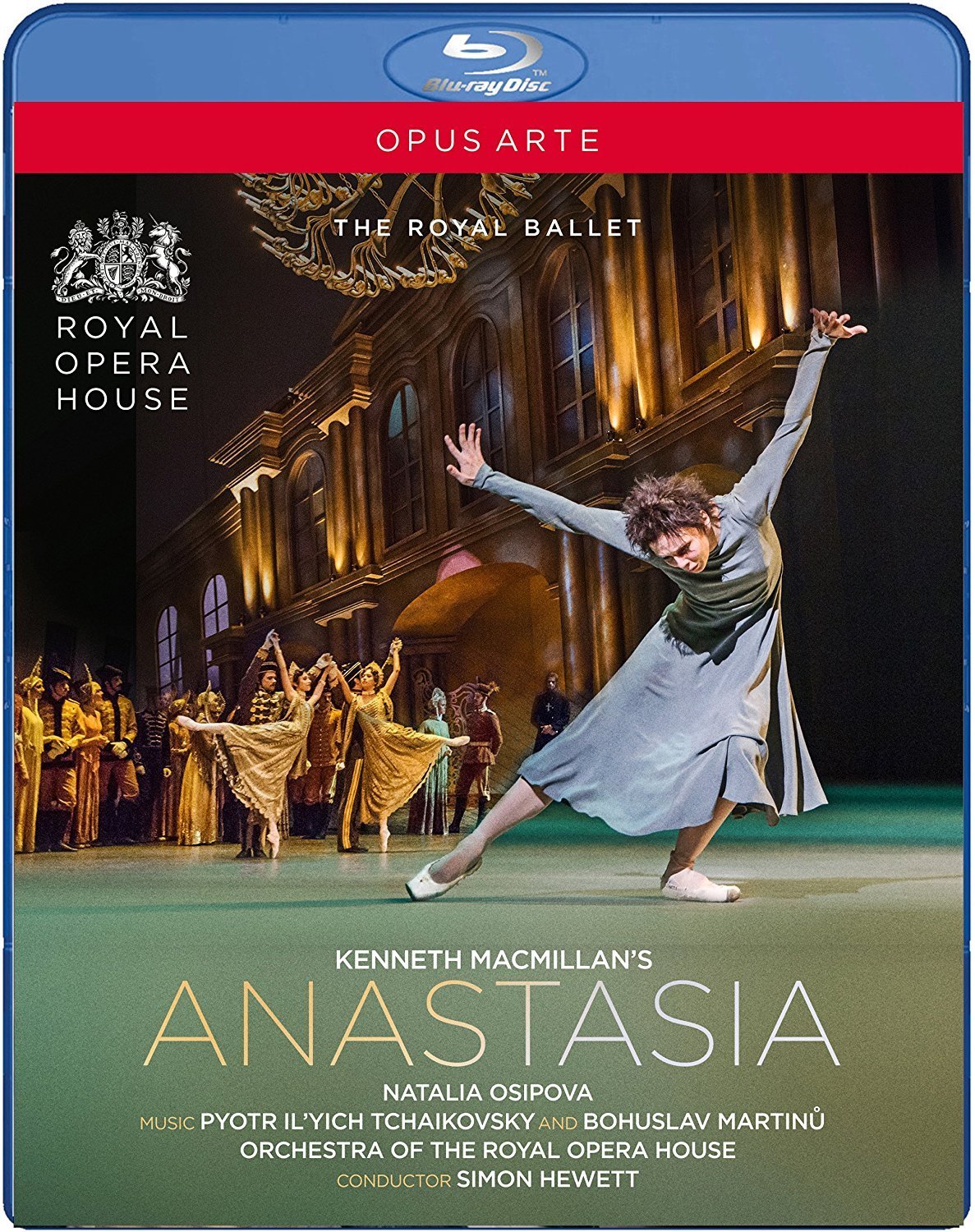
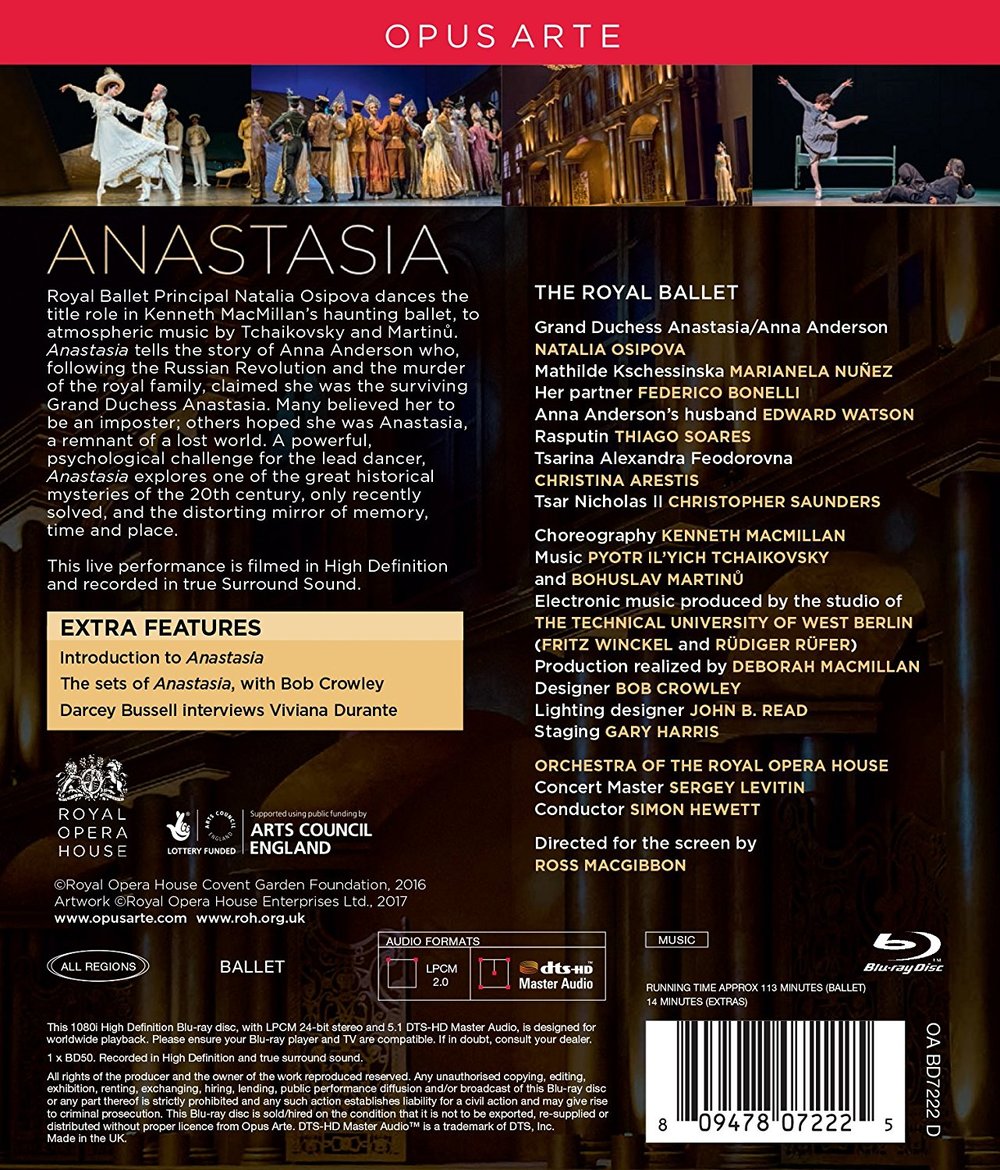
Anastasia ballet. Music by Tchaikovsky and Bohuslav Martinů. Choreography by Kenneth MacMillan as realized by Deborah MacMillan. Staged 2016 at the Royal Ballet. Stars Christopher Saunders (Tsar Nicholas II); Christina Arestis (Tsarina Alexandra Feodorovna); Rory Toms (Tsarevitch Alexey); Olivia Cowley (Grand Duchess Olga); Beatriz Stix-Brunell (Grand Duchess Tatiana); Yasmine Naghdi (Grand Dutchess Marie); Natalia Osipova (Grand Duchess Anastasia); Thiago Soares (Rasputin); Kristen McNally (Anna Vyrubova/Matron/Peasant woman); Alastair Marriott (Tsar's Aide-de-Camp); Ryoichi Hirano, Valeri Hristov, Alexander Campbell, and Edward Watson (Four Officers). Also features:
Act 1. Luca Acri, Tristan Dyer, and and Marcelino Sambé (Three Officers); Mica Bradbury (Maid).
Act 2. Marianela Nuñez (Mathilde Kschessinska); Federico Bonelli (Kschessinska’s Partner); Vincenzo Di Primo (Revolutionary).
Act 3. Natalia Osipova (Anna Anderson); Edward Watson (Anna Anderson's husband); Tristan Dyer (Anna Anderson's Brother-in-Law).
Artists of the Royal Ballet as Officers, Guests, Soldiers, Revolutionaries, Nurses, Peasants, Visitors, Relatives.
Simon Hewett conducts the Orchestra of the Royal Opera House (Concert Master Sergey Levitin). Electronic music provided by the studio of The Technical University of West Berlin (Fritz Winckel and Rüdiger Rüfer); designs by Bob Crowley; lighting design by John B. Read; staging by Gary Harris. Directed for TV by Ross MacGibbon. Released 2017, disc has 5.1 dts-HD Master Audio sound. Grade: B+
This is from the 2016 revival at the ROH. Both Laura Morera and Natalia Osipova were well received in the lead, but Osipova is the more famous and got the star berth in the video.
Grand Duchess Anastasia was the youngest daughter of the last Russian Tsar. We now know that the Bolsheviks murdered Anastasia (then age 17) with all the rest of the Tsar's family on July 17, 1918. But Kenneth MacMillan never knew this---he died before the true fate of Anastasia was revealed through DNA sleuthing. Some 30 women claimed to be Anastasia. One of them, a Polish peasant named Franzisca Schanzkowska, was successful at this in a way truly stranger than fiction---all this is brilliantly explained in the keepcase booklet by Frances Welch, a Russian history expert. Suffice to say now that when MacMillan choreographed this work, he didn't know if his ballet was a sad true story of ironic suffering or a depiction of a fraud perpetrated by a mental patient. So MacMillan wrote a ballet that works fine either way!
Below we encounter Tsarina Alexandra Feodorovna (Christina Arestis) with her four daughters. They are, from left to right, Grand Duchess Marie (Yasmine Naghdi), Grand Duchess Tatiana (Beatriz Stix-Brunell), Grand Duchess Olga (Olivia Cowley) and Grand Duchess Anastasia (Natalia Osipova):
The family enjoys an outing on the royal yacht. The woman in gray is Anna Vyrubova (Kristen McNally), the Tzarina's best friend (MacMillan has lots of fine touches like this on stage to keep you on your trivia toes):
Anastasia, the naughtiest of the 4 girls, takes off her roller skates to cavort with the young officers. They treat her like a little sister:
Christopher Saunders below bears a remarkable resemblance to Tsar Nicholas II. Here he reads with Tsarevitch Alexey (Rory Toms). Alexey is heir to the throne, but he suffers from a terrible case of hemophilia:
Even a simple fall at play is a life-threatening crisis for Alexey. The peasant priest Rasputin (Thiago Soares) has a way of helping Alexey recover from his injuries. Rasputin leveraged this talent into bizarre influence over the Tsarina and her daughters:
Even though the Russian Empire is being depleted by WWI, the Tsar and Tsarina take out time to introduce Anastasia to society at a glittering ball. Rasputin is always hovering about:
The stage design gives many hints that all of Act 1 is taking place at a mental hospital in the mind of Franzisca Schanzkowska. Most of these design elements are hard to see in screenshots, but you can't miss the unreal chandeliers:
But even though Act 1 is a fantasy, it's loaded with convincing production values like the nice costumes below:
At the ball, Mathilde Kschessinska (Marianela Nuñez) entertains with a partner (Federico Bonelli). Kschessinska was one of the most famous (and infamous) prima ballerinas of the 19 century and the era of Petipa. She was mistress to Nicolas II before he married Alexandra Feodorovna. She migrated west after the Russian Revolution and remained an indomitable figure in dance until her last performance at age 64 --- at the Royal Ballet at Covent Garden! So MacMillan had to include Kschessinska in his Anastasia:
Anastasia is introduced to society:
But the party is crashed by the Reds:
Now below we see Natalia Osipova as Franzisca Schanzkowska, who called herself Anna Anderson upon entering a mental-illness hospital in Berlin. Later Schanzkowska claimed to be Grand Duchess Anastasia and was believed by many. The 3 names for her can be confusing---from here on I'll generally just call her Anastasia:
Nurses try to help Anastasia by showing her movies of life before the Revolution in Russia. The film below is a famous shot of the royal family with images of the real Anastasia when she was about 6:
Anastasia displays a genius at creating the ambiguity required to keep her claims afloat:
White Russian visitors arrive. Some immediately declare Anastasia to be an impostor; others fall for Anastasia's stories:
MacMillan next takes us into Anastasia's mind as she remembers (or imagines, it turned out) horrific events in Russia (including the Bolshevik murders when Anastasia was 17) and how she miraculously made her way to the West after escaping execution. The common thought behind all 30 Anastasia impostors was the notion that someone in the Bolshevik chain-of-command took pity on Anastasia because of her youth and spirited her away.
Rasputin again---he was accused of impropriety with all the women in the Tsar's family:
Anastasia imagines her husband (Edward Watson), who was one of those who rescued her:
And the ballet ends with the mystery unsolved. In fact, Anastasia was eventually discharged from the hospital. She later migrated to the United States where she had further wild adventures with folks who chose to believe she was a Grand Duchess! If someone wanted to revise Anastasia, he could add an Act 4 about the life enjoyed by Franzisca Schanzkowska in the New World!
This is a big show with many characters depicting two entirely different worlds: (1) the opulence of the Romanov dynasty prior to the Revolution and (2) the poverty and degradation of an mental patient striving to convince the world that she was a refugee from the Romanov downfall. The two worlds could hardly have been more different. The nationalistic and romantic Tchaikovsky music during Acts 1 and 2 is, of course, radically different from the modern, abstract electronic music of Martinů in Act 3. Whatever you think about this startling libretto, you will be impressed by Osipova as she dances and acts brilliantly in both worlds. (Fantasy thought: why not film this also with Laura Morera and include both versions in the package!)
This show should stand repeated viewing thanks to excellent choreography, fine production values, cogent personal directing, and the many elements MacMillan wove into the plot to appeal to trivia buffs. The music is interesting and both PQ and SQ are good.
This bring us to our final consideration: video content. I did a Ballet Wonk Worksheet. The pace of the video clips is consistent through all 3 acts at about 9 seconds per clip. As you can see from our discussion of ballet video best practices, this pace is too fast for good viewer comfort. The worksheet also reveals that there are too many close-up, waist/torso, and no-feet clips. Only about 60% of the total clips show the whole bodies of the dancers. In other words, the baleful influence of DVDitis is noticed throughout, and this will keep this title off our list of best ballet titles. Still, this is an enjoyable and unique show that will probably please most dance fans who enjoy both traditional and modern productions. Because of the weak video content, I grade this down to a B. But then, for Osipova's versatility I give the grade a bump up to B+, which, I remind you, is a good grade on this website. If MacGibbon had slowed down the pace (as Vincent Battailon probably would have done) this could have been an A or A+ title.
Here's a clip about the performance with Osipova:
OR



